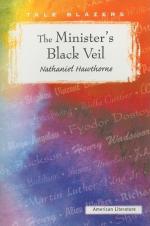|
This section contains 3,556 words (approx. 12 pages at 300 words per page) |

|
SOURCE: “Ironic Unity in Hawthorne's ‘The Minister's Black Veil,’” in American Literature, Vol. 34, No. 2, May, 1962, pp. 182-90.
In the following essay, Stibitz maintains that Hawthorne used irony in his portrayal of the minister's decision to wear the black veil.
Because Hawthorne is always very much the same and yet also surprisingly varied, one way of understanding “The Minister's Black Veil,” as with any Hawthorne tale, is to read it not only as the unique work of art that it is, but as a tale comparable to others by Hawthorne, viewing it in the context of his essentially consistent thought and art as a whole. Such a reading of “The Minister's Black Veil” yields an unambiguous meaning. Hawthorne, with his usual assumption of the reality of personal evil, presents on one level his fundamental belief in man's proneness to hide or rationalize his most private thoughts or guilt. This...
|
This section contains 3,556 words (approx. 12 pages at 300 words per page) |

|


